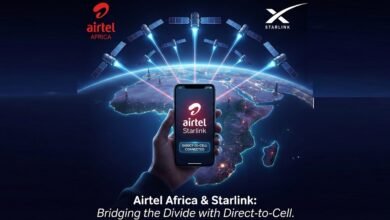Starlink, the satellite internet service operated by SpaceX, has solidified its place as a serious contender in Kenya’s competitive internet service market. Licensed in early 2023, the provider has already amassed over 8,000 subscribers, making it the tenth-largest Internet Service Provider (ISP) in the country by the end of June 2024, according to the Communications Authority of Kenya (CA).
This rapid expansion reflects growing demand for reliable internet access, particularly in remote and underserved regions, where traditional ISPs have struggled to build infrastructure. Starlink’s entry signals the start of a more competitive internet landscape that could reshape access across the country.
Market Overview: Starlink’s Impact on ISP Subscriptions
The CA’s Fourth Quarter 2023/24 Sector Statistics Report shows that Kenya’s ISP market is dominated by key players like Safaricom PLC, Jamii Telecommunications Ltd (JTL), and Wananchi Group, with Starlink quickly emerging as a significant competitor.
| ISP | Subscribers | Market Share (%) |
|---|---|---|
| Safaricom PLC | 545,812 | 36.4 |
| Jamii Telecommunications Ltd | 360,446 | 24.0 |
| Wananchi Group (Zuku) | 263,008 | 17.5 |
| Poa Internet | 198,609 | 13.2 |
| Starlink Internet Services | 8,063 | 0.5 |
Starlink’s 0.5% market share may appear modest compared to Safaricom and JTL, yet the satellite-based ISP has achieved this growth within just one year. In comparison, many ISPs take several years to establish a presence. The flexibility of satellite infrastructure enables Starlink to circumvent the need for costly fibre networks, making it a practical solution for areas where ground-based infrastructure is scarce or non-existent.
Affordable Pricing: Starlink’s Edge in a Competitive Market
Starlink’s subscription plans appeal to a diverse range of customers by offering competitive speeds at affordable rates:
- KES 1,300 ($10) per month for speeds of up to 200 Mbps.
- KES 4,000 ($31) per month for a 100 Mbps residential package.
These prices are lower than many comparable packages from other ISPs, especially those using fibre infrastructure. Traditional ISPs, including Safaricom and Wananchi Group, often bundle their internet services with higher operational costs, reflected in their pricing structures.
Mobile Connectivity and Broadband Growth:
Kenya’s growing mobile broadband penetration has laid the groundwork for increased internet demand. As of June 2024, mobile broadband subscriptions reached 38.5 million, driven by the expansion of 4G and early 5G networks.
The mobile market continues to thrive:
- Total SIM subscriptions: 68.9 million (133.7% penetration rate).
- Smartphone users: 35.2 million, accounting for 68.3% penetration.
- Mobile data users: 52.5 million, showing a 2.5% growth in subscriptions.
With 39.8 million mobile money subscribers, digital financial inclusion has increased significantly. Notably, the removal of restrictions between M-Pesa and Airtel Money – allowing direct wallet-to-wallet transfers – has further streamlined financial transactions.
This mobile-first environment creates fertile ground for ISPs like Starlink, which can tap into high demand for internet services both for individuals and businesses.
Bandwidth and Satellite Internet: A Shift in Kenya’s Internet Infrastructure
The report highlights a significant shift in Kenya’s internet infrastructure, with satellite services becoming increasingly important. The total international bandwidth capacity grew by 2.4% to 21,244.3 Gbps. More notably, Starlink’s entry resulted in a 1,635% increase in satellite bandwidth consumption, rising from 48.4 Gbps to 840.4 Gbps by June 2024.
This trend underscores the potential of satellite internet to complement traditional fibre networks, particularly in rural areas where laying cables is impractical.
Challenges and Competition: Safaricom’s Response to Starlink’s Expansion
Starlink’s disruptive presence has not gone unnoticed by competitors. Safaricom, the market leader, has actively lobbied the Communications Authority to impose stricter regulations on satellite operators like Starlink. Safaricom argues that satellite ISPs should not operate independently but instead partner with local providers to ensure fair competition.
In a bid to retain its market dominance, Safaricom upgraded its fibre speeds and introduced new packages aimed at reducing customer churn. Additionally, other ISPs have offered discounts and promotional packages to maintain their user base, responding directly to Starlink’s competitive pricing model.
Interestingly, Safaricom has not entirely ruled out the possibility of collaboration with Starlink. While no formal announcements have been made, the potential for such a partnership could allow Starlink to leverage Safaricom’s vast logistical and distribution network, enhancing its reach across Kenya.
Roaming and Connectivity: A Broader Perspective
Kenya’s internet and telecom ecosystem is not limited to ISP competition. Roaming traffic data from the report offers insights into broader connectivity trends:
- Inbound roaming traffic increased by 6.3%, while outbound roaming traffic declined by 7.9%.
- These shifts reflect the dynamics of both domestic and international internet usage, as Kenyans increasingly rely on Over-the-Top (OTT) platforms for messaging and voice calls, reducing the need for traditional SMS and voice services.
The Future of Internet Access in Kenya: Starlink’s Role
The arrival of Starlink represents more than just the addition of a new ISP; it highlights the evolving nature of Kenya’s internet market. With high-speed, low-latency satellite internet, Starlink is well-positioned to serve remote areas that have traditionally been neglected by fibre and mobile networks.
The CA report acknowledges this shift, stating that satellite internet’s scalability and ease of deployment make it a viable option for expanding broadband access to underserved regions. This development aligns with Kenya’s broader goal of increasing digital inclusion by ensuring access to reliable internet for all citizens.
Conclusion: Starlink’s Impact and the Road Ahead
Starlink’s expansion in Kenya marks a pivotal moment in the country’s digital landscape. Its ability to establish a 0.5% market share within one year—competing with long-established players—demonstrates the growing demand for high-speed internet.
While challenges remain, including regulatory hurdles and stiff competition from local ISPs, Starlink’s unique value proposition offers a glimpse into the future of internet connectivity. With affordable pricing, high speeds, and a focus on underserved areas, Starlink could continue to reshape how internet access is delivered in Kenya.
The report’s findings suggest that Kenya’s internet market is at a turning point, where satellite technology, mobile broadband, and fibre networks must coexist to meet the rising demand. As competition intensifies, consumers are likely to benefit from lower prices and better services, positioning Kenya as a leader in digital transformation across Africa.








